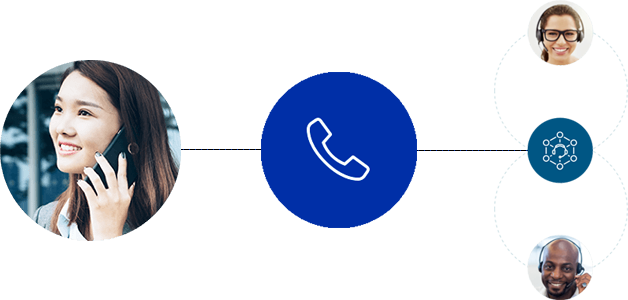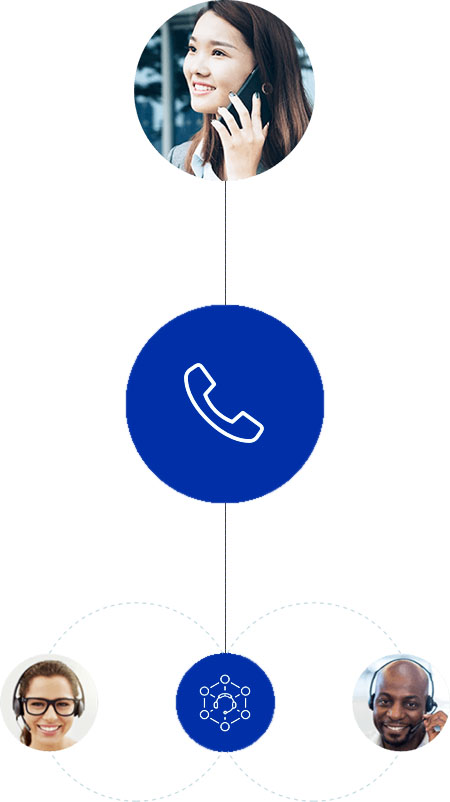Want to know more about how an easy-to-use IVR system can take your call center to another level? Sign up for a personal demo and our solutions specialist will contact you and show you the ropes.
VoIP Phone Service - How It Works for Your Business
Easy setup. No hardware required.
Thank you.
A RingCentral sales advisor will contact you within 24 hours

Forecast call volume and align resources properly
Prevent over- and understaffing agents as call volume fluctuates, using a statistical model to optimize schedules. The RingCentral workforce management system improves customer satisfaction, reduces employee discord, and minimizes labor costs.

INTERACTIVE VOICE RESPONSE MEANING
What is IVR?
Interactive voice response or IVR is an automated business phone system feature that interacts with callers and gathers information by giving them choices via a menu. It then performs actions based on the answers of the caller through the telephone keypad or their voice response.
The choices of the caller decide the actions of the IVR — it can provide information or, if the issue is more complex, route callers to a human agent who can better handle their needs.
If you ever called a business phone number and had been answered by an automated greeting, which proceeded to interact with you via some pre-recorded message, then you know what an IVR is.
What is IVR payment?
This is an IVR feature that allows customers to make payments for bills, fees, etc over the phone. This is usually achieved by integrating your IVR system with third-party payment gateway applications that have security and compliance measures in place to protect customers. For more information, contact RingCentral.

Improve customer experience
Reduce churn and meet expectations for shorter waiting periods and first contact resolution. RingCentral workforce management software provides you with the insight to staff the right number of agents with the appropriate skill sets for rapid resolutions.
How does ACD work?
The call distribution process can be summed up in three steps:
- Caller information and identification
- Call queueing
- Call routing
Here is a diagram of the process:


STEP 1. Caller Identification
As mentioned above, the first step is asking the caller’s purpose through an IVR. Caller ID systems can also be used to determine factors like language and location. This will allow the ACD to distribute the caller to an agent that’s best equipped to handle their concern.
STEP 2. Call Queueing
As mentioned above, the first step is asking the caller’s purpose through an IVR. Caller ID systems can also be used to determine factors like language and location. This will allow the ACD to distribute the caller to an agent that’s best equipped to handle their concern.
- Status
- Waiting time
- Query
VIPs are usually prioritized over others, but the system can also be programmed to sort callers based on the other factors mentioned above.
STEP 3. Call Routing
The last step is call routing. The ACD will route the calls based on your preferred type of distribution method.
Want to minimize customer waiting time? The ACD can distribute the incoming call to whoever’s immediately available. Want your customer to be handled by the best agent? You can set the system to distribute based on an agent’s skills.
There are many types of distribution methods for you to choose from. To help you determine which one is the best for your business, let’s look at the most commonly-used methods in call centers.
Different types of call distribution
Each type of distribution method has its pros and cons. Some prioritize speed while others boost agent productivity. If you’re having those issues in your business, choose a routing strategy that can help fix it.
Rotary call distribution
A common distribution type for centers that want agents to have equal volumes of workload. In rotational distribution, agents all take turns in answering. For example, call 1 is taken by agent 1, call 2 is taken by agent 2, and so on. The cycle then repeats from the first agent once everyone has taken a turn.
Fixed order call distribution
In this type, the agents are arranged in a fixed order, and calls are initially distributed to just the first person on the list. Calls are only sent to the next agent if the previous one is busy. This is a good choice if you have agents that are more experienced and can resolve matters faster than others.
Rotary call distribution
In this type, the agents are arranged in a fixed order, and calls are initially distributed to just the first person on the list. Calls are only sent to the next agent if the previous one is busy. This is a good choice if you have agents that are more experienced and can resolve matters faster than others.
Rotary call distribution
In this type, the agents are arranged in a fixed order, and calls are initially distributed to just the first person on the list. Calls are only sent to the next agent if the previous one is busy. This is a good choice if you have agents that are more experienced and can resolve matters faster than others.
- Aenean lacinia bibendum nulla sed consectetur. Maecenas faucibus mollis interdum. Donec ullamcorper nulla non metus auctor fringilla. Etiam porta sem malesuada magna mollis euismod. Maecenas faucibus mollis interdum.
- Aenean lacinia bibendum nulla sed consectetur. Maecenas faucibus mollis interdum. Donec ullamcorper nulla non metus auctor fringilla. Etiam porta sem malesuada magna mollis euismod. Maecenas faucibus mollis interdum.
- Aenean lacinia bibendum nulla sed consectetur. Maecenas faucibus mollis interdum. Donec ullamcorper nulla non metus auctor fringilla. Etiam porta sem malesuada magna mollis euismod. Maecenas faucibus mollis interdum.
- Aenean lacinia bibendum nulla sed consectetur. Maecenas faucibus mollis interdum. Donec ullamcorper nulla non metus auctor fringilla. Etiam porta sem malesuada magna mollis euismod. Maecenas faucibus mollis interdum.
In this type, the agents are arranged in a fixed order, and calls are initially distributed to just the first person on the list. Calls are only sent to the next agent if the previous one is busy. This is a good choice if you have agents that are more experienced and can resolve matters faster than others.
| Call Center | Contact Center | |
|---|---|---|
| Supported Channels |
|
|
| Advantages |
|
|
| Disadvantages |
|
|
In this type, the agents are arranged in a fixed order, and calls are initially distributed to just the first person on the list. Calls are only sent to the next agent if the previous one is busy. This is a good choice if you have agents that are more experienced and can resolve matters faster than others.
Different types of call distribution
In this type, the agents are arranged in a fixed order, and calls are initially distributed to just the first person on the list. Calls are only sent to the next agent if the previous one is busy. This is a good choice if you have agents that are more experienced and can resolve matters faster than others.
- Forecasting - Predict future workload and call drivers by identifying trends and patterns. A WFM software solution should provide you with the historical data and insight you need to come up with accurate forecasts. You’ll find that a lack of labor demand forecasting results in reduced productivity and profitability.
- Scheduling - Let managers take on the role of a workforce scheduler, defining the shifts and hours that would cover customer communication patterns across all platforms based on forecasts. When done well, the critical business process of employee scheduling allows for the most efficient call center schedules, ensuring improved client service, enhanced employee experience, and reduced labor cost.
- Assigning agents - Meet operational needs by assigning agents to appropriate shifts. In doing so, a business manager typically considers factors like agent performance, call handling ability, preference, and tenure. Many contact centers observe policies like shift swapping, which affords agents the flexibility of trading shifts when the need arises.
- Intraday management - Manage day-to-day operations efficiently with workforce solutions. WFM doesn’t end when you’re done creating forecasts and schedules or assigning agents. Keep in mind that in a contact center, anything can happen at any moment. When you have what you need to manage your workforce, you can address issues like absenteeism or unexpected spikes in call volumes caused by:
- Technical outages or difficulties
- Increased customer complaints
- Product recalls
- Unpublicized marketing campaigns
- Negative media exposure
- Technical outages or difficulties
H2 headline goes here
Donec sed odio dui. Praesent commodo cursus magna, vel scelerisque nisl consectetur et. Morbi leo risus, porta ac consectetur ac, vestibulum at eros. Nullam id dolor id nibh ultricies vehicula ut id elit.
Cras mattis consectetur purus sit amet fermentum. Donec ullamcorper nulla non metus auctor fringilla. Maecenas faucibus mollis interdum. Nullam id dolor id nibh ultricies vehicula ut id elit. Cum sociis natoque penatibus et magnis dis parturient montes, nascetur ridiculus mus. Cras justo odio, dapibus ac facilisis in, egestas eget quam.
Morbi leo risus, porta ac consectetur ac, vestibulum at eros. Morbi leo risus, porta ac consectetur ac, vestibulum at eros. Aenean eu leo quam.
Donec sed odio dui. Praesent commodo cursus magna, vel scelerisque nisl consectetur et. Morbi leo risus, porta ac consectetur ac, vestibulum at eros. Nullam id dolor id nibh ultricies vehicula ut id elit.
Cras mattis consectetur purus sit amet fermentum. Donec ullamcorper nulla non metus auctor fringilla. Maecenas faucibus mollis interdum. Nullam id dolor id nibh ultricies vehicula ut id elit. Cum sociis natoque penatibus et magnis dis parturient montes, nascetur ridiculus mus. Cras justo odio, dapibus ac facilisis in, egestas eget quam.
Morbi leo risus, porta ac consectetur ac, vestibulum at eros. Morbi leo risus, porta ac consectetur ac, vestibulum at eros. Aenean eu leo quam.
Donec sed odio dui. Praesent commodo cursus magna, vel scelerisque nisl consectetur et. Morbi leo risus, porta ac consectetur ac, vestibulum at eros. Nullam id dolor id nibh ultricies vehicula ut id elit.
Cras mattis consectetur purus sit amet fermentum. Donec ullamcorper nulla non metus auctor fringilla. Maecenas faucibus mollis interdum. Nullam id dolor id nibh ultricies vehicula ut id elit. Cum sociis natoque penatibus et magnis dis parturient montes, nascetur ridiculus mus. Cras justo odio, dapibus ac facilisis in, egestas eget quam.
Morbi leo risus, porta ac consectetur ac, vestibulum at eros. Morbi leo risus, porta ac consectetur ac, vestibulum at eros. Aenean eu leo quam.
Sign up for a free personal demo
A solution specialist will contact you for a personalized, informative demo on the key features and benefits of RingCentral Contact Center.
Thank you.
A RingCentral sales advisor will contact you within 24 hours
